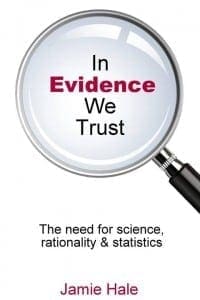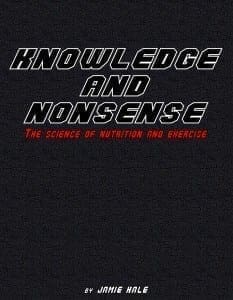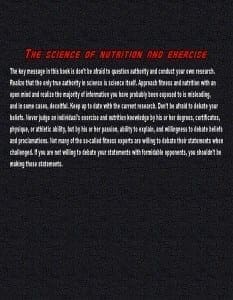In 2005 I had an idea to write a book about scientific and rational thinking. I started writing the book that year, but progress was slow. In 2006 and 2007 I wrote a few books on different subjects; however I continued to work on the 2005 idea. In 2010 I completed another book; this one was on exercise and nutrition myths. I began working with Eastern Kentucky University’s Perception and Cognition Lab and Psychophysiology Lab in 2011. By 2013, in addition to working with the labs, I had begun working as an instructor (teaching facilitator) at EKU. January 1, 2014 my idea- In Evidence We Trust– came to fruition.
Purchase e-books, In Evidence We Trust: The need for science, rationality and statistics and Nutrition: Fact or Fiction for only $29.95.
What scientists are saying about In Evidence We Trust
“A great introduction to scientific thinking, useful for the student and the general reader alike” …Keith E. Stanovich, Emeritus Professor, University of Toronto, author of How To Think Straight About Psychology
“A useful, informative, and engaging compendium of critical thinking tools. Should come in handy for novices and experts alike. I recommend it!” …Scott O. Lilienfeld, Ph.D., Professor, Department of Psychology, Emory University, Atlanta, Georgia, co-author of 50 Great Myths of Popular Psychology.
“Intelligent people make poor decisions every day. They use emotion over evidence, fantasy rather than fact, and superstition instead of science. Much of this has to do with a general state of scientific illiteracy and the inability to think critically. Jamie Hale’s new book is a major step in overcoming this problem.” …Brian Jones, Ph.D., Assistant Professor, Kinesiology and Health Studies, Georgetown College, Georgetown, KY.
“Most undergraduate curriculum focus on training students in their knowledge areas. More recently, there has been some emphasis put on thinking skills like critical thinking and scientific reasoning. Yet the vast majority of textbooks still present scientific knowledge as though it is a finished product: someone a lot smarter than the average student figured all this stuff out, and the textbook contains “the truth.” Very few textbooks introduce critical thinking and scientific reasoning as a process that we have to go through, and even fewer lay out what the components of the process are and how students should work through them. Jamie Hale’s book is an excellent supplement to any science course because it introduces students to the landscape of the process of scientific thought.” …Richard Osbaldiston, Ph. D., Associate Professor, Department of Psychology, Eastern Kentucky University, Richmond, KY.
Contents
Acknowledgements ………………………………………………………………………………………………….1
Introduction …………………………………………………………………………………………………………..2
Chapter 1: The Need for Science and Statistics ……………………………………………………………6
The Skeptic ……………………………………………………………………………………………………………..7
Scientific & Nonscientific Approaches to
Knowledge ………………………..……………………………………………………………………………………17
Science Might Have it Wrong? ….……………………………………………………………………………..29
The Common Sense Myth! …..…………………………………………………………………………………..31
Correlational Studies are Important Even if They Don’t Imply Causation! ……………………34
Why We Need Statistics! ……..…………………………………………………………………………………..36
When Experts are Wrong ……..………………………………………………………………………………….39
Understanding Scientific Research Methods ……………………………………………………………..48
Why Science Matters by James Randi ……………………………………………………………………….55
The Nonsense Detection Kit ……………………………………………………………………………………..57
Science Roundtable: Discussing Scientific Matters ……………………………………………………..67
Guidelines for Reading Research Reports ….………………………………………………………………80
Chapter 2: The Need for Rationality …..……………………………………………………………………..83
Developing The RQ Test ……….………………………………………………………………………………….84
Good Thinking: More Than Just Intelligence .…………………………………………………………….92
Intelligence and Rationality: different cognitive abilities …………….……………………………….95
The Ultimate Goal of Critical thinking ….…………………………………………………………………..100
Man is an Irrational Animal! ……….…………………………………………………………………………..104
Common Myths About Rationality ……..…………………………………………………………………….111
Dysrationalia: Intelligent People Behaving Irrationally ……………………………………………… 114
Chapter 3 FAQ: Research Methods and Statistics ……………………………………………………….123
References ………………..…………………………………………………………………………………………….177
Appendices ………..……………………………………………………………………………………………………185
Appendix A Practice Problems …………………………………………………………………………………..185
Appendix B APA Style Citation and Reference Lists …………………………………………………….194
Appendix C Recommended Readings: Popular Science Books …………….………………………..197
Index ……………………………………………………………………………………………………………………….200
About the Author ……………………………………….……………………………………………………………..204




